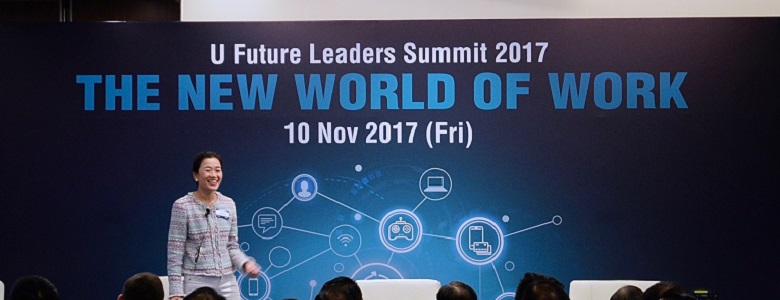It’s the Fourth Industrial Revolution. Do you know where your jobs are at?

- Societies and individuals must start preparing for the changing nature of work
- High-tech, high-touch and high-trust jobs are less susceptible to automation; people in these vocations, however, still stand to benefit from the use of technology
- To stay relevant, workers and businesses must reskill themselves, rethink their industries for the digital age and revisit negative mindsets towards innovation
The question of “Will I be replaced by a robot?” may well be the defining existential crisis of the 21st century. With the Fourth Industrial Revolution—referring to the combination of technologies such as artificial intelligence (AI), robotics and the Internet of Things that is blurring the lines between the physical and digital worlds—at our doorstep, there is an urgent need for both societies and individuals to rethink the nature of work.
“We cannot wait until there are massive dislocations in society to prepare for the Fourth Industrial Revolution. We have to start thinking ahead about which jobs need to be reskilled,” said Ms Jacqueline Poh, Chief Executive of the Government Technology Agency of Singapore (GovTech), in her keynote address at the NTUC U Future Leaders Summit 2017.
Held on 10 November, this year’s edition of NTUC’s flagship conference focused on the need for professionals, managers and executives across all industries to stay relevant in the digital age, and on how they can equip themselves with the skills needed for jobs that may not have existed in the past.
“I’m an optimist when it comes to technology, so I do believe that it creates more jobs,” said Ms Poh, pointing to social media marketers, online community managers and digital strategists as examples of how this is already happening today.
Three ‘highs’ for the Fourth Industrial Revolution
Not all jobs are equally susceptible to automation. “When I am asked about what jobs are going to remain in the Fourth Industrial Revolution, I tend to bucket them into three categories: high-tech, high-touch and high-trust,” said Ms Poh. People in high-tech jobs—data scientists, cybersecurity specialists and machine learning experts for example—will remain highly sought-after because they create the technologies that drive the digital world, she explained.
Meanwhile, high-touch vocations—nurses, teachers and counsellors, for instance—will also endure. “People have a need for empathy, for bedside manner and for someone to talk to.”
Finally, because people do not yet have the same level of confidence in robots or AI, there will still be a need for high-trust professionals such as doctors, judges and arbiters.
That being said, people in just about every job—even in high-touch vocations such as teaching—stand to benefit from the use of technology. For example, to help teachers learn from one another, GovTech and the Ministry of Education have developed the Student Learning Space, an online portal where educators from all schools can share course materials and teaching strategies, said Ms Poh. At the same time, students also benefit from having access to a bigger pool of resources.
Getting digitally ready for the workplace
Thus, workers looking to stay relevant must find ways to use technology to their advantage, said Ms Poh, who offered what she called the ‘3Rs’ of how they could do this.
Reskilling, the first ‘R’, involves upping one’s digital literacy game, and workers could do this by taking relevant courses in areas new to them, for example. In Singapore, citizens as young as primary school-aged children can use the MySkillsFuture portal to find useful courses, said Ms Poh.
Although digital readiness for every professional is a major focus for the government, reskilling should not be done for the sake of jumping onto the technology bandwagon or hype cycle, said Ms Poh. Before diving into a programming or machine learning course, workers should first think carefully about how it would benefit them.
“Technology is going to move at a very fast pace. If you want to reskill yourself, you have to keep up with it and understand which bits are most relevant to the work that you do, and the use cases you encounter,” she advised.
No demons here, just innovation
Next, because digital technology is fast erasing distinctions between industry sectors, workers and businesses should be rethinking their industries for disruption (the second ‘R’), continued Ms Poh. “Sectoral boundaries are beginning to blur in the internet age—e-commerce, for example, involves retail, logistics and digital infocomms technology all at the same time.”
In response to these blurring lines, the government is rolling out the National Trade Platform, which will allow for easier interactions between businesses, as well as between businesses and government agencies, said Ms Poh.
Finally, Ms Poh addressed the need to revisit mindsets towards innovation (the third ‘R’). In the Middle Ages, people were afraid of Belphegor, a demon who was said to tempt humanity with ingenious inventions, encouraging laziness and a slothful attitude. “There was a time when people felt that innovation was an evil thing to want,” said Ms Poh.
But this mindset has no place in today’s digital economy, she emphasised. “We don’t really have that option [of fearing innovation] in Singapore—we haven’t had that option since independence. If we give in to the idea that innovation is something to avoid or something that is evil, we get complacency.”
https://www.tech.gov.sg/media/technews/its-the-fourth-industrial-revolution-do-you-know-where-your-jobs-are-at
